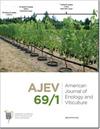Autonomous Phenological Development in Different Merlot Grapevine Shoots
IF 1.8
3区 农林科学
Q3 BIOTECHNOLOGY & APPLIED MICROBIOLOGY
引用次数: 1
Abstract
The common viticulture practice called “green thinning,” performed to improve uniformity of ripeness, is based on an underlying assumption that shoots (and their respective clusters) on the same grapevine are phenologically autonomous. There is no empirical evidence to support this assumption. The theory of phenological shoot autonomy in grapevines was tested over three seasons in three different Merlot vineyards located in Napa Valley. A trial was established comparing early pruning versus late pruning of spurs on separate vines or applied to the same vine in two forms: opposite cordons on the same vine or alternate spurs on the same vine. Phenological stages were followed on shoots from one vine per replicate for each treatment combination using an updated Eichhorn-Lorenz (E-L) scale from budbreak to end of veraison. The ordinal logistic regression analysis of the median phenological stages for all seasons revealed an effect of pruning date, but not pruning unit. Budbreak was delayed by 10 days the first season, by seven to nine days the second season, and between 10 and 13 days in 2020 with late pruning. Veraison was delayed five to eight days each season with late pruning on both separate vines and same vine treatments. The analysis of fruit composition three to five weeks after veraison was complete (E-L 41) also showed a lower Brix with late pruning on separate vines or the same vine, and that there was no interaction between pruning date and pruning unit in any vintages. Overall, the results support the phenological shoot autonomy theory in grapevines.不同梅洛葡萄芽的自主物候发育
常见的葡萄栽培实践称为“绿色间伐”,用于提高成熟的均匀性,是基于一个潜在的假设,即同一株葡萄藤上的芽(及其各自的簇)在物候上是自主的。没有经验证据支持这一假设。在纳帕谷的三个不同的梅洛葡萄园中,对葡萄植株物候自主理论进行了三个季节的测试。建立了一项试验,比较了在单独的葡萄藤上对马刺进行早期修剪和后期修剪,或以两种形式应用于同一葡萄藤:在同一葡萄藤上相反的警戒线或在同一葡萄藤上交替的马刺。采用更新的Eichhorn-Lorenz (E-L)量表对每个处理组合的每个重复的枝条进行物候阶段的跟踪研究,从出芽到版本结束。对各季节物候期中位数进行有序logistic回归分析,发现剪枝时间的影响不受剪枝单位的影响。第一季的发芽时间推迟了10天,第二季推迟了7到9天,2020年由于修剪晚了,发芽时间推迟了10到13天。每个季节,在单独的葡萄藤和相同的葡萄藤处理上进行晚修剪,将变色推迟5到8天。改良完成后3 ~ 5周(e - l41)的果实成分分析也显示,在单独的单株或同一株上进行晚修剪,果实的白利度较低,而且在任何年份,修剪日期和修剪单位之间没有相互作用。总体而言,研究结果支持葡萄物候茎自主理论。
本文章由计算机程序翻译,如有差异,请以英文原文为准。
求助全文
约1分钟内获得全文
求助全文
来源期刊

American Journal of Enology and Viticulture
农林科学-生物工程与应用微生物
CiteScore
3.80
自引率
10.50%
发文量
27
审稿时长
12-24 weeks
期刊介绍:
The American Journal of Enology and Viticulture (AJEV), published quarterly, is an official journal of the American Society for Enology and Viticulture (ASEV) and is the premier journal in the English language dedicated to scientific research on winemaking and grapegrowing. AJEV publishes full-length research papers, literature reviews, research notes, and technical briefs on various aspects of enology and viticulture, including wine chemistry, sensory science, process engineering, wine quality assessments, microbiology, methods development, plant pathogenesis, diseases and pests of grape, rootstock and clonal evaluation, effect of field practices, and grape genetics and breeding. All papers are peer reviewed, and authorship of papers is not limited to members of ASEV. The science editor, along with the viticulture, enology, and associate editors, are drawn from academic and research institutions worldwide and guide the content of the Journal.
 求助内容:
求助内容: 应助结果提醒方式:
应助结果提醒方式:


